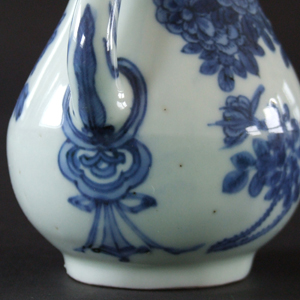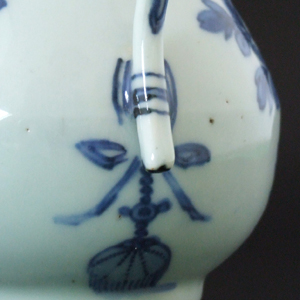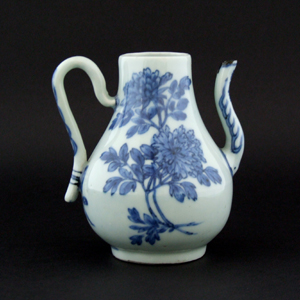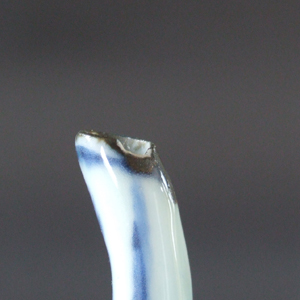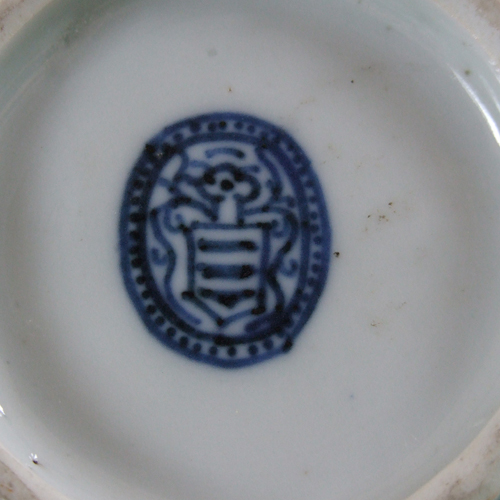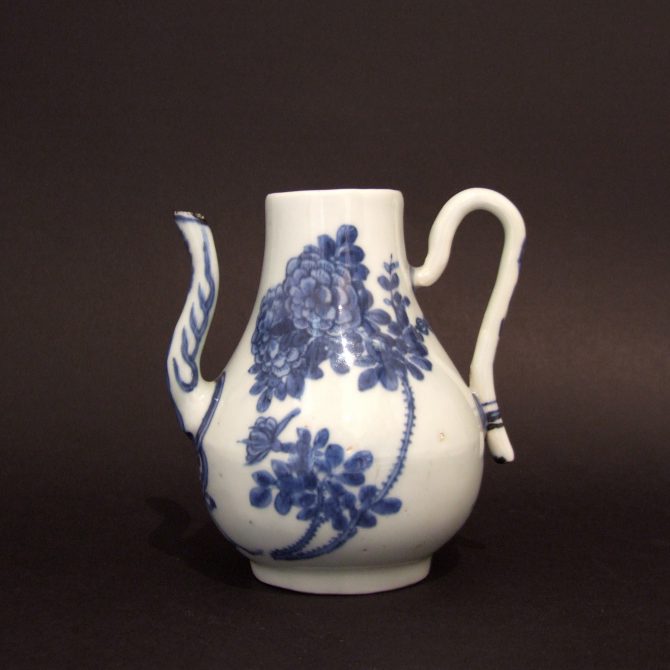
TIANQI, MADE FOR D.FRANCISCO DE MASCARENHAS c.1623-1626 Ming Porcelain
A Very Rare Ming Dynasty Portuguese Armorial Blue and White Porcelain Ewer, Tianqi Period c.1621-1627. Made For D.Francisco de Mascarenhas in c.1623-1626. The Base is Painted with the Arms of the Mascarenhas Family in Underglaze Blue, the Design is Thought to Have Been Taken From a Signet Ring. The Bulbous Ewer Has a Slender Handle with an Upright Curve, The Base of the Handel is Painted to Look if it is Tied with Ribbon that Supports a Decorative Object. The Upright Spout is Decorated with Stylized Flames or Clouds, the Broader Area Where the Spout Joins the Body is Decorated with a Concentric Ribbon Supporting a Ruyi Which in Turn Supports a Precious Object, a Musical Stone Tied with Ribbon. One Side is Painted with a Large Flowering Rose, While the Other Side is Decorated with a Large Flowering Peony.
SOLD
- Condition
- A small shallow chip to the end of the spout
- Size
- Height : 11.1 cm (4 1/3 inches).
- Provenance
- N/A
- Stock number
- 23423
- References
- For a blue and white Kraak porcelain ewer and a two handled jar with the arms of D.Francisco de Mascarenhas see : Chinese Porcelain At The Time Of Empire (Nuno de Castro, ACD Editions, 2007. ISBN 978-9728855-39-0) page 96.
Information
This Ming armorial ewer is very different to other armorial porcelain in that the arms are very discrete. Armorial porcelain normally proclaims the families pedigree in the center of the object where they eye would naturally rest, it is there for all to see and admire. The small coat of arms of D.Francisco de Mascarenhas are added to the bases of pieces he owned, rather like the drilled Near Eastern marks added to celadon wares. They are there to identify ownership rather than make a statement about lineage. Unlike the drilled marks, the mark on the present piece was made at the time of manufacture. The design and shape give no indication of being a commission from an important Portuguese nobleman.
D.Francisco de Mascarenhas 1st Governor of Macau :
"Nobleman of the Royal House, he set sail for India in 18/3/1622 commanding the ship S.Jose, as part of the fleet of D.Francisco da Gama appointed Viceroy. Because of fighting against the Dutch off the coast of Mozambique, in which his ship was severely damaged, he only arrived in Goa in 6/5/1623. He was immediately appointed the Captain-General and 1st Governor of Macau, a post he held until 24/4/1626. During his governance, he improved the city`s defence system, by enclosing it behind a high wall. As well as other problems he created with the population, he confiscated the Monte fortress from the Jesuits, which he used as his residence. He returned to Lisbon in 1626, and in 1628 he was appointed Viceroy of India, but owing to a breakdown of his ship, he returned to Lisbon and did not take up his appointment. He was assigned to the Council of Portugal in Madrid. At the time of Independence in 1640, by wishing to return to Portugal, he was imprisoned for several months, and after being released he returned to Lisbon and was appointed to the Council of State by King D.João IV.
The son of D.Nuno de Mascarenhas, First Alcaide of Castelo de Vide and Da. Isabel de Castro. He married his niece Margarida de Vilhena, daughter of D.João Mascarenhas."
From : Chinese Porcelain At The Time Of Empire (Nuno de Castro, ACD Editions, 2007. ISBN 978-9728855-39-0).
For an painting of Macau executed in 1635 see the last photograph.
Rose and Peony / Yueji and Fuguihua :
The combination of these two flowers conveys the meaning `May You Enjoy Eternal Spring (Longevity), Wealth and Honour`.
Peony :
Peonies are the most commonly encountered flower on Chinese porcelain, indeed in Chinese art in general. There are two cultivated types of peony commonly depicted, the tree peony Paeonia Suffruicosa (Mudan) and the herbaceous peony P.Lactiflora (Shaoyao). Both have rich exuberant flowers with thin silk like petals but the plants are rather different to each other. The tree peony is not in fact a tree but a deciduous shrub, sometimes rather large and sprawling, it has irregular woody stems. It shares a similar leaf and flower form to the herbaceous peony but they are not close in other ways. The Chinese refer to the peony as the `King of flowers` and are seen as equivalent to the first rank among officials. The flowers are closely associated with royalty because they have been grown in imperial gardens since the Sui dynasty (581-618). The peony is one of the flowers of the four seasons and represents the Spring. It symbolizes wealth and honour, honour in the sense of high rank, having an official position, or high social status.
